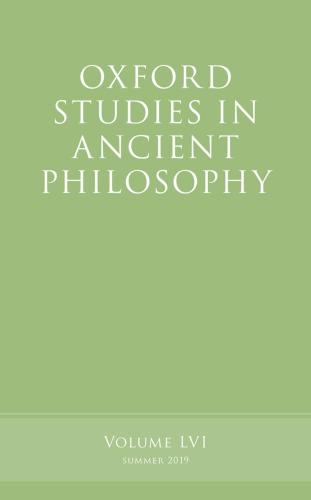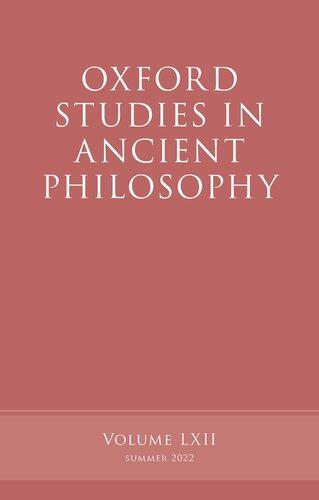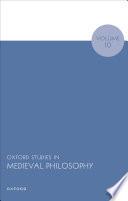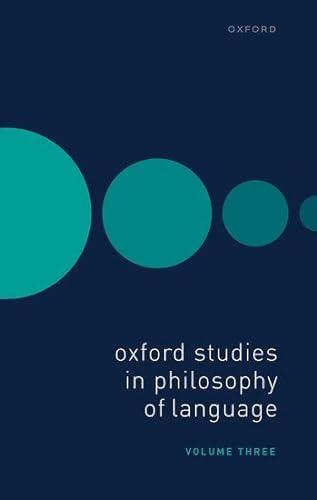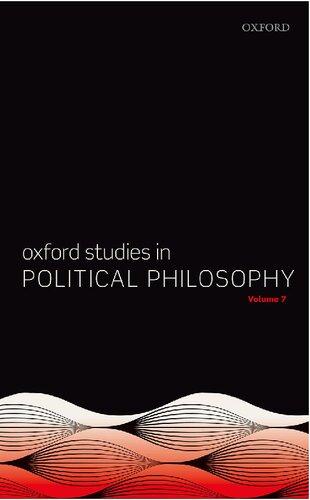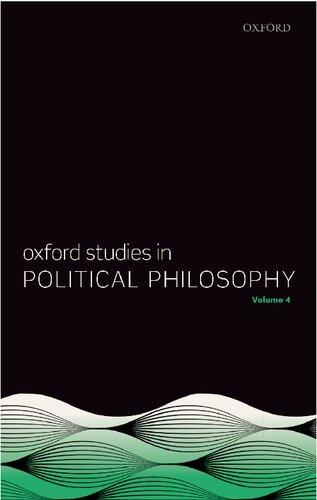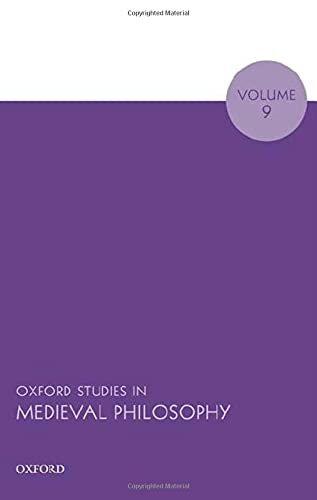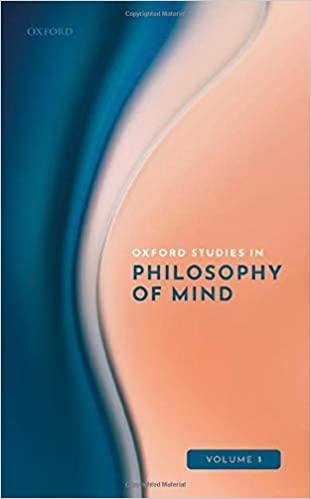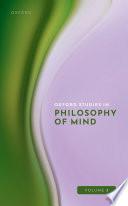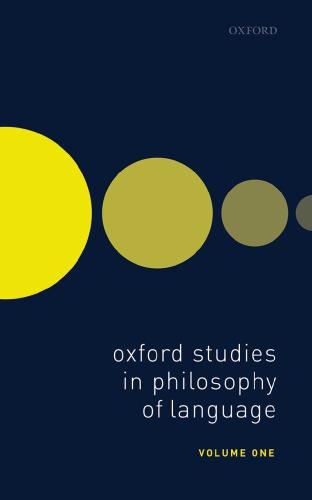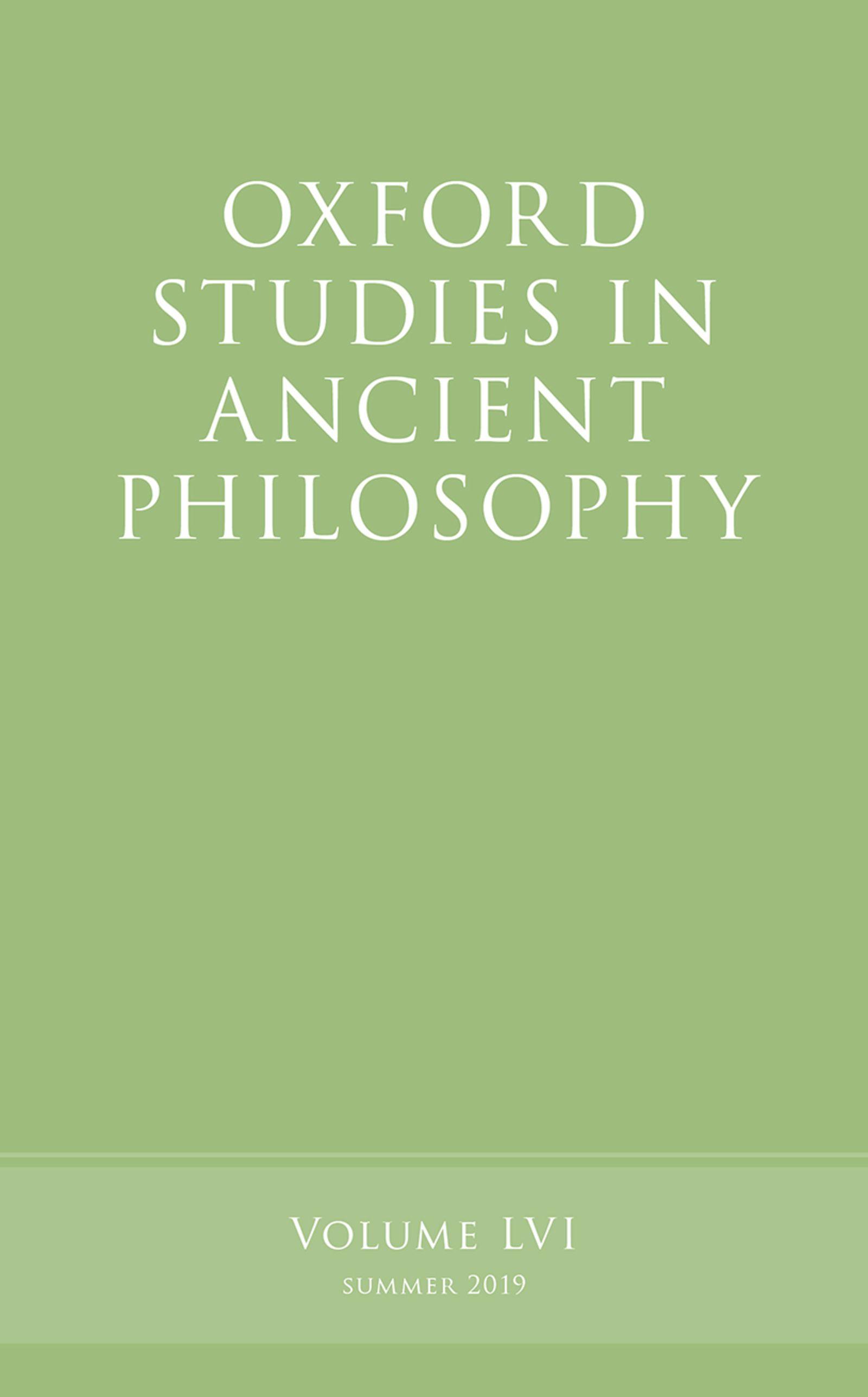THE WORLD AS A HARMONY: PHILOLAUS’ METAPHYSICS OF HARMONIC STRUCTURES AND THE HIERARCHY OF LIVING BEINGS
laura rosella schluderer
1. Introduction
Over the last few decades, there has been a growing recognition of the importance of fifth-century thinkers such as Philolaus and Archytas in the formation of a Pythagorean philosophy, as well as the beginnings of an appreciation of their contribution to early Greek thought.1 In support of this development, my paper studies
© Laura Rosella Schluderer 2019
An early version of this article first saw the light of day as the opening chapter of my Cambridge PhD thesis, entitled ‘Microcosm and Macrocosm in Philolaus and Plato’s Philebus: The Metaphysics of Harmonic Structure’. I am extremely grateful to my supervisor, James Warren, for pointing me towards Philolaus’ fragments, as well as for his unfailing support and guidance in writing about ancient metaphysics. I am also grateful to David Sedley, my second supervisor, and Geoffrey Lloyd, Malcolm Schofield, and Richard McKirahan for reading the chapter and offering careful observations and useful objections, which turned it into a better work of scholarship. Finally, I deeply thank the anonymous external reader of Oxford Studies in Ancient Philosophy and the editor, Victor Caston, for their insightful and acute remarks, which helped me bring into clearer focus my strategy and findings, and helping to improve the presentation.
1 Cf. C. A. Huffman, Archytas of Tarentum: Pythagorean, Philosopher, and Mathematician King (Cambridge, 2005) and ‘Plato and the Pythagoreans’ in G. Cornelli, R. McKirahan, and C. Macris (eds.), On Pythagoreanism (Berlin, 2013), 237–70; M. Schofield, ‘Pythagoreanism: Emerging from the Presocratic Fog (Metaphysics Α 5)’ [‘Emerging’], in C. Steel (ed.), Aristotle’s Metaphysics Alpha (Oxford, 2012), 141–66; D. W. Graham, ‘Philolaus’, in C. A. Huffman (ed.), A History of Pythagoreanism [History] (Cambridge, 2014), 46–68. The notorious Aristotelian label ‘the so-called Pythagoreans’ may indeed possibly be due to their status as natural philosophers, which distinguished them from those who were properly called Pythagoreans, i.e. the adherents of a way of life. On the label, see W. Burkert, Lore and Science in Ancient Pythagoreanism [Lore], trans. E. L. Minar, (Cambridge, Mass. 1972) at 30 n. 8, and more recently O. Primavesi, ‘Aristotle on the “so-called Pythagoreans”: From Lore to Principles’, in Huffman, History, 227–49. On the role of Philolaus and other fifth-century Pythagoreans in relation to Plato’s thought, see recently Huffman, ‘Plato and the Pythagoreans’; P. S. Horky,
Laura Rosella Schluderer
Philolaus’ explanatory model based on musical harmonia, arguing for its analytical power and potential breadth of application. I attempt to do so by extrapolating from the extant texts a reconstruction of Philolaus’ metaphysical system and how it might have worked when applied to both the micro- and macrocosmic ontological levels. A good deal of what follows is, therefore, speculative and very much open to discussion. Yet I believe that exploring the theoretical implications of what Philolaus explicitly says is a worthy enterprise, which goes some of the way towards doing justice to his contributions to the development of ancient metaphysics.
I focus on a number of Philolaus’ fragments (DK 44 B 1, B 2, B 6, B 6a, B 7, B 13) and testimonia (A 16, A 17, Anon. Lond. 18. 8–29 Manetti = A 27),2 as well as some of Aristotle’s reports on Pythagorean cosmogony whose connection to Philolaus’ writings has been definitively established (fr. 201 Rose, Phys. 4. 6, 213b22–6, Metaph. Ν. 3, 1091a15–18).3 In particular, I shall start from B 13 and its intriguing hierarchy of living beings, and move on to the other texts where Philolaus’ analytical schema of limiters, unlimiteds, and harmonia is outlined, and finally propose an interpretation of how this schema may have applied to the scala naturae of B 13. In connecting B 13 to the whole of Philolaus’ metaphysical and ontological apparatus, I have the following goals in mind: (1) to show the metaphysical structure underlying the hierarchy of living beings, faculties, and organs in B 13; (2) to demonstrate how Philolaus’ conception of living beings is deeply integrated with the rest of his metaphysical and cosmological view; and more importantly, (3) to show how, by employing a peculiar notion of harmonic, mathematical structure modelled on musical harmonia as a paradigm for cosmological harmony, Plato and Pythagoreanism (Oxford/New York, 2013); J. Palmer, ‘The Pythagoreans and Plato’ [‘Pythagoreans’], in Huffmann, History, 204–26.
2 References to fragments (‘B’) and testimonia (‘A’) are to H. Diels and W. Kranz (eds.), Die Fragment der Vorsokratiker [DK], 6th ed. (Berlin, 1951–2).
3 See C. A. Huffman, Philolaus of Croton: Pythagorean and Presocratic [Philolaus] (Cambridge, 1993), who develops the approach of Burkert’s epoch-making Lore; also see Schofield, ‘Emerging’, for Philolaus’ book as the basis of Aristotle’s reports on Pythagoreans. For a different methodological approach, see L. Zhmud, ‘Some Notes on Philolaus and the Pythagoreans’ [‘Notes’], Hyperboreus, 4 (1998), 243–70, and Pythagoras and the Early Pythagoreans [Pythagoras], trans. K. Windle and R. Ireland (Oxford, 2012). For the recent resurgence of interest in Philolaus’ studies, see R. McKirahan, ‘Philolaus on Number’ [‘Philolaus’], Proceedings of the Boston Area Colloquium in Ancient Philosophy, 27 (2012), 211–32; Graham, ‘Philolaus’.
The World as a Harmony 3
Philolaus possesses a rather sophisticated explanatory framework, which could fairly well account for the structure of the cosmos and all living beings in it.4 I suggest a way in which such an account could have worked, and how, in the light of this interpretation, Philolaus’ cosmos may be analysed in terms of increasingly complex harmonic structures, formed of interconnected substructures, covering the whole micro-macrocosmic range, from cosmogony and cosmology down to embryology and the taxonomy of living beings.5
Let us then consider B 13:
(DK 44 B 13)6
And there are four principles of the rational animal, as Philolaus says in his book On Nature, namely, brain, heart, navel, and genitals: ‘The head [contains the arche] of intellect, the heart that of psuche and perception, the navel of rooting and first growth, the genitals of the sowing and generation of seed. The brain [contains] the arche of the human being, the heart that of the animal, the navel that of the plant, and genitals the arche of all these together, for it is from seed that everything flourishes and grows’.7
The fragment is noteworthy for a number of reasons. First of all, while scholars have often pointed to a microcosm-macrocosm pattern in Philolaus, in the form of a general analogy between his cosmogony and his embryology,8 this is the only surviving text in
4 For the peculiarity of Philolaus’ notion of harmonia with respect to others who employed it as a model, e.g. Heraclitus and Empedocles, see below, n. 51.
5 Pathology as exposed in Anon. Lond. 18. 30–19. 1 and 20. 21–4 Manetti would be a further field of application, but issues of space prevent me from developing it here.
6 Unless otherwise noted, I follow Huffman’s text and line numbers. Here I accept Sedley’s supplements (‘The Dramatis Personae of Plato’s Phaedo’ [‘Phaedo’], in T. J. Smiley (ed.), Philosophical Dialogues: Plato, Hume, Wittgenstein (Oxford, 1995), 3–26 at 23), contra Huffman, Philolaus, 307.
7 I have used Huffman’s translations, with modifications.
8 Huffman, Philolaus, 213, 296; Burkert, Lore, 271; A. Olerud, L’idée de macrocosmos et de microcosmos dans le Timée de Platon (Uppsala, 1951), 47 ff.; G. S. Kirk and J. E. Raven, The Presocratic Philosophers (Cambridge, 1957), 313; H. C. Baldry, ‘Embryological Analogies in Pre-socratic Cosmogony’ [‘Analogies’], Classical
Laura Rosella Schluderer
which Philolaus explicitly addresses the nature of living beings, if one discounts the embryological testimony preserved in the medical papyrus Anonymus Londiniensis (Anon. Lond. 18. 8–29 Manetti = A 27). It is therefore unique within the corpus, so much so that its authenticity has sometimes been questioned.9 Secondly, the fragment sketches a plant-animal-man hierarchy, which, though it might not seem uncommon,10 is actually uniquely complex and stratified. Indeed, the fragment not only establishes a hierarchy of beings, but also distinguishes each of them by a specific organ and faculty. Moreover, its description of these various hierarchical relationships pivots on the key term arche, which requires clarification.11
First of all, it is unclear whether arche is to be interpreted here as a temporal beginning or as an explanatory principle, or perhaps as both, and so in what sense the brain possesses, or is, the arche of the human being, or the heart the arche of the animal. Secondly, it seems important to understand in what way each arche relates to the lower, subordinate ones, since at every step in the hierarchy each arche seems to be somehow subsumed under the level that is ‘above them’ in the scala (since it is clearly not the case that, on the appearance of e.g. brain, the heart disappears, and so on). Finally, we may wonder whether this ‘stacking’ or layering of archai one over the other applies to the development of individual organisms,
Quarterly, 26 (1932), 27–34 at 33; E. Zeller and R. Mondolfo, La filosofia dei Greci nel suo sviluppo storico, 2 vols. (Florence, 1938), 370; E. Frank, Plato und die sogennanten Pythagoreer: Ein Kapitel aus der Geschichte des grieschischen Geistes [Plato] (Halle, 1923), 327 ff.; W. K. C. Guthrie, A History of Greek Philosophy, vol. i: The Earlier Presocratics and the Pythagoreans [History] (Cambridge, 1962), 278 ff.; G. E. R. Lloyd, Polarity and Analogy: Two Types of Argumentation in Early Greek Thought (Cambridge, 1966), 238 n. 2.
9 Cf. e.g. C. H. Kahn, ‘Democritus and the Origins of Moral Psychology’, American Journal of Philology, 106 (1985), 1–31 at 20 n. 45, though see Huffman, Philolaus, 307 ff. for a defence.
10 The same sequence, or parts of it, features in other authors: cf. Empedocles: Al-Sharastani, DK 1. 358, in the note on l. 16; Diogenes Apollonius DK 64 A 19. 44 = Theophr. De Sens. 44, ‘plant and animal’ in B 2; on the differentiation of man and animal, Alcmaeon DK 24 B 1a, Archelaus DK 60 A 4. 6 = Hippol. Ref. 1. 9. 6.
11 This is why I have left the term untranslated throughout. Notoriously, both the use and meaning of arche among early natural philosophers is a matter of controversy: Melissus (DK 30 B 2) and Heraclitus (DK 22 B 103) employ it in its simple meaning of ‘beginning’; but whether Anaximander was the first to use it, and if so (as e.g. M. C. Stokes, One and Many in Presocratic Philosophy [One] (Cambridge, Mass., 1971), 28 ff.), in what sense, is a vexed question, which has implications for the interpretation of Milesian cosmologies generally. See more below, n. 24. For Philolaus on arche, see below, n. 15.
The World as a Harmony 5 or to the development of the species as whole (that is to say, whether the fragment describes the ontogenetic or the phylogenetic level), or again to both.
My proposal for reading B 13 within the broader context of Philolaus’ fragments rests on two facts. First, the key term arche also appears in the crucial B 6, where it is specifically used to characterize limiters and unlimiteds, i.e. what Philolaus regard as the cosmos’ ultimate constituents. Second, in B 1 and B 2 Philolaus insists that not only the cosmos as a whole (ὅλος ὁ κόσμος), but also all the things in it (καὶ τὰ ἐν αὐτῷ πάντα), and so presumably all living beings too, are constituted from the combination of limiters and unlimiteds. Such an approach entails an overall reconsideration of Philolaus’ framework. I shall first clarify the relations between limiters, unlimiteds, and harmonia (Section 2); I shall then elucidate Philolaus’ specific notion of harmonia with particular reference to the musical fragment B 6a (Section 3) and clarify the nature of limiters and unlimiteds (Section 4); finally, I shall suggest how such an analysis might work (Section 5), by then applying it to the cosmos as a whole and the hierarchy of living beings outlined in B 13 (Section 6).
2. The logical relations of limiters, unlimiteds and harmonia
Let us begin with fragment B 6:
Regarding nature and harmony the situation is as follows: the being of things, which is eternal, and nature itself admit of knowledge that is divine
12 This is the MS reading, but the text is generally regarded as corrupt (an exception is Burkert, Lore, 251 n. 64). For a discussion of the possible corrections, none of which he regards as fully convincing, see Huffman, Philolaus, 143–4.
Laura Rosella Schluderer
and not human, except that it was impossible for the things that are and are known by us to have come to be if the being of things from which the world-order was constituted did not exist, both the limiters and the unlimiteds. But since these archai existed, being neither alike nor akin, it would have been impossible for them to be ordered if a harmony had not supervened, in whatever way it came to be. Things that are alike and things that are akin did not need any harmony, but it is necessary that things that are unlike and not akin and not of [the same speed] be bound together by harmonies, if they are to be held in an order.
Limiters and unlimiteds are termed archai immediately after being referred to as that without which (μὴ ὑπάρχουσαι) it would have been impossible for the things that are and are known by us to have come to be. It is undetermined here whether we should take archai as indicating temporal, logical, or ontological priority, or whether huparchein should be taken as ‘being present to’ or as ‘being already present, pre-existing’.13 But at this stage all that is necessary is to take huparchein in its use as ‘existing’, which is neutral with regard as to whether they also pre-exist, and interpret the counterfactual claims as stating necessary conditions:14 if limiters and unlimiteds did not exist, the world as we know it and all the things in it would not exist. B 6 thus makes clear that limiters and unlimiteds are responsible for the fact that the world is as we know it and accordingly suggests that the term arche is something that is endowed (at least) with a causal and explanatory role as well.15 Fragment B 2, indeed, might lead us to think that Philolaus’ claim about limiters and unlimiteds is stronger than mere necessity:
13 Both are attested in fifth-century writers; see M. Nussbaum, ‘Eleatic Conventionalism and Philolaus on the Conditions of Thought’ [‘Eleatic’], Harvard Studies in Classical Philology, 83 (1979), 63–108 at 101 n. 94. Huffman, Philolaus, 136–7 favours the second reading.
14 For counterfactual arguments in fifth-century writers, see Diog. Ap. DK 64 B 3; Anaxag. DK 59 B 12; Her. DK 22 B 23; Zeno DK 29 B 1–3; Melissus DK 30 B 6–7; see Burkert, Lore, 260. For modern analyses of causation in terms of counterfactuals, see the classic D. Lewis, ‘Causation’, Journal of Philosophy, 70 (1973), 556–67, and J. Pearl, Causality (Cambridge, 2000).
15 On Philolaus’ role in developing the notion of arche as ‘explanation’, see Huffman, Philolaus, 78 ff., M. Schofield, ‘Ἀρχή’, Hyperboreus, 3 (1997), 218–36 at 222.
. (DK 44 B 2)
It is necessary for the things that are to be either all limiting or all unlimited or both limiting and unlimited; but not in every case unlimited only. Now, since it is manifest that neither are they from limiting things only, nor from unlimited things only, it is clear then that the cosmos and the things in it were fitted together from both limiting and unlimited things. Things in their actions16 make this clear too. For some, coming from limiters only, limit; others, coming from both limiters and unlimiteds both limit and do not limit; and others, coming from unlimiteds only, will manifestly be unlimited.
In the first sentence, Philolaus sets out the logical possibilities for the ‘things that are’ (τὰ ἐόντα). With Huffman, I take ‘the things that are’ to be not all the individual things in the world,17 but their basic constituents.18 Philolaus is thus here presenting three options: the basic constituents consist in (i) only limiters; (ii) only unlimiteds; or (iii) both limiters and unlimiteds. He also makes a point of specifying that such basic constituents are not ‘in every case/at all times unlimiteds only’, possibly because unlimiteds are attractive candidates as the only principles,19 and many of Philolaus’ predecessors conceived them as such20—a view Philolaus specifically wants to reject. On the other hand, he does not need to add here the parallel claim ‘nor limiters only’,21 since there had not ever been support for the view that limiters were the only archai 22
16 For the interpretation of τὰ ἐν τοῖς ἔργοις, see below, Section 3.
17 As Nussbaum, ‘Eleatic’, 97; Burkert, Lore, 259 ff.; J. Barnes, The Presocratic Philosophers [Presocratic], 2nd rev. ed. (New York, 1982), 386.
18 Huffman, Philolaus, 103 ff.
19 Perhaps this is because they seem able to exist separately from limiters, for example, in a pre- or extra-cosmic state: cf. a number of Aristotelian reports (Metaph. Ν. 3, 1091a15 ff.; fr. 201 Rose = Stob. Ecl. 1. 18. 1c; Phys. 4. 6, 213b22 ff., all quoted below, Section 4) suggesting that the Pythagoreans—and Philolaus (see below, n. 84)—envisaged the region outside the heavens as a reservoir of unlimiteds; see Huffman, Philolaus, 212. See also Arist. Phys. 3. 4, 203a4–8, a passage especially devoted to the study of the unlimited as arche, reporting that the Pythagoreans held that what is ‘outside the cosmos is unlimited’ (τὸ ἔξω τοῦ οὐρανοῦ ἄπειρον, a7–8).
20 Consider Anaximander with his ἄπειρον (DK 12 B 1), Anaximenes with air (DK 13 A 1 = D.L. 2. 3, A 6 = Ps.-Plut. Strom. 3) and Anaxagoras asserting that all things were together unlimited (ἄπειρα, DK 59 B 1) in respect of both number and smallness.
21 I follow Huffman, Philolaus, 101, 104, in regarding Diels’ supplement <ἢ περαίνοντα μόνον> as unnecessary, contra Burkert, Lore, 250, and Barnes, Presocratic, 386.
22 This is in line with the fact that the notion of ‘limit’ is inherently dependent on that of unlimited: it is self-evident that limiters cannot exist by themselves and so
Laura Rosella Schluderer
In the second sentence, Philolaus then develops his argument by shifting from basic constituents to individual things.23 After setting out the possibilities for the basic constituents, he turns to the structure of the world-order and all the things in it, and argues that, given what we commonly observe, we must conclude that these were fitted together from both limiters and unlimiteds, and thus that the basic cosmological constituents comprise both limiters and unlimiteds.
Two points are worth raising here: (1) at first glance, one might think that according to B 2 limiters and unlimiteds are not only necessary but also jointly sufficient for the world to exist as it does. And (2), in both B 2 and B 6 the composition of the cosmos and things in it from limiters and unlimited is expressed by the ambiguous preposition ek
, B 6), which raises the same question that applies to arche: is this use of the preposition ek constitutive or derivative? Are limiters and unlimiteds ‘items’ the world and all things in it are made of, right now, or are they the original ‘items’ the world and all things in it come from?24 To settle these issues, we must turn to the pivotal notion of harmonia
For once we include harmonia in the picture, it becomes clear that (1) limiters and unlimiteds are not all that is needed for the cosmos to come to be, even though they are in fact its only constituents; and that (2) both the constitutive and derivative senses of ek, and accordingly of arche, are in play. Let me explain how. Recall the second sentence of B 6, explicitly stating that the composition of the world-order requires a third indispensable factor:
But since these archai existed being neither alike nor akin, it would have been impossible for them to be ordered if a harmony had not supervened.
Such a harmonia, however—and this must be emphatically stressed— is not to be understood as a further arche, or as a constitutive element of the same sort as limiters and unlimiteds: its ontological status and role are essentially different, as we shall see.
cannot be the only archai. Cf. Barnes, Presocratic, 387 and Nussbaum, ‘Eleatic’, 98. Cf. B 3, which also rules out the possibility that all things consist solely of unlimiteds.
23 For this analysis of the argument, see Huffman, Philolaus, 103–5.
24 Cf. the vexed question in relation to Milesian archai: see Barnes, Presocratic, 38 ff., for the Material Monism view (supported by Aristotle in Metaph Α), against the Generative Substance Theory introduced by Stokes, One, 30 ff. and developed by D. W. Graham, Explaining the Cosmos (Princeton, 2006).
To clarify this, it is important to note at this point that the fragments let us glimpse two senses of harmonia. On the one hand, the lines just quoted prompt an interpretation of harmonia as an additional principle acting upon the other two, which pre-exist it. On the other, consider ll. 2–3 of B 2 (above) and B 1:
. (DK 44 B 1)
Nature in the world-order was fitted together from unlimiteds and limiters, both the world-order as a whole and all the things in it.
Here, it appears that each and every combination of limiters and unlimiteds is a harmonia, for each and every time that a limiter and an unlimited, being unlike and not akin, are held together, it is because they are harmonically combined (ἁρμόχθη). Thus the cosmos and all things in it, inasmuch as they are unified compositions of the unlike limiters and unlimiteds, just are harmonic combinations, harmoniai: indeed, they cannot be anything else, if they are thus held together in an orderly composition. This is further confirmed by the fact that in B 1 and B 2 harmonia does not appear as a third entity, but is expressed by a verb (ἁρμόζειν, B 1; συναρμόζειν B 2), indicating the harmonic way in which limiters and unlimiteds are fitted together. So harmonia appears to be both an extra intervening factor, binding opposite components into unity, and each combination of limiters and unlimiteds that results from this binding. 25 I submit that precisely this ambivalence26 is essential to Philolaus’ notion of harmonia and may be exploited to exhibit its effectiveness as an explanatory model in cosmology and metaphysics.
3. The ontological status and nature of harmonia
The key for grasping harmony’s special ontological status and function lies in the notion of musical harmonia, which Philolaus develops in B 6a. First, a word on the relation between B 6 and B 6a: the musical
25 The reader will already be alerted to the similarity of this with Empedocles’ Love, as reconstructed and criticized by Aristotle in DA 1. 4; see below, n. 52 and Section 5 n. 90 for further discussion.
26 Huffman, Philolaus, seems to be aware of the ambiguity, as he generally calls harmonia a ‘third principle’ (e.g. 158), but also recognizes that it is not an arche in the same way as limiters and unlimiteds (e.g. 140 ff.); however, he does not offer an interpretive solution.
Laura Rosella Schluderer
fragment is widely considered to be continuous with B 6, concerning the cosmological harmonia, and the two have traditionally been printed together.27 But more relevantly for my point, Huffman has put forth a strong argument against the objection that the two fragments cannot be continuous due to different notions of harmonia being in play.28 This transition, Huffman maintains, is indeed the key move in Philolaus’ theoretical enterprise. The role of B 6a is precisely that of characterizing cosmological harmonia in terms of the ratios of numbers that structure the diatonic scale, a move in turn that makes perfect sense in light of Aristotle’s report that the Pythagoreans recognized that harmonics is governed by number and were consequently willing to conceive of the whole cosmos as a harmony.29
The musical B 6a specifies precisely how we are to interpret the magnitude of the harmonia according to which limiters and unlimiteds combine to form the whole world and all things in it (B 6, B 1, B 2). Moreover, if we thus connect B 6a with B 6 and the other cosmological fragments, we may plausibly conclude that the same numerical structure that governs musical harmony may be found in all existing individual things, since it is only by being harmonically fitted together from limiters and unlimiteds in this way that they exist, and exist in the way they do.
Thus, as others have already stressed, musical harmony works for Philolaus as an explanatory paradigm, which can be generalized from music to apply to other phenomena.30 If this is correct, it
27 On B 6a as belonging together with B 6, and Philolaus’ primary concern being on cosmology, see A. Boeckh, Philolaus der Pythagoreers Lehren nebst den Bruchstücken seines Werkes [Philolaus] (Berlin, 1819), 65; Burkert, Lore, 1972; Huffman, Philolaus, 158; McKirahan, ‘Philolaus’, 217 ff. Stobaeus quotes the two fragments as continuous (Ecl. 1. 21. 7d); Diels separates them by only a dash.
28 See Huffman, Philolaus, 158–60 contra P. Tannery, ‘À propos des fragments philolaïques sur la musique’ [‘Musique’], Mémoires scientifiques, 3 (1904), 220–43 at 238.
29 Arist. Metaph. Α. 4, 985b31–986a3: ‘. . . since, again, they saw that the attributes and ratios of the harmonia are found in numbers [ἔτι δὲ τῶν
] . . . they supposed that [ὑπέλαβον] . . . the whole heaven is a harmonia and a number [τὸν ὅλον οὐρανὸν
καὶ ἀριθμόν]’ (trans. A. Barker, Greek Musical Writings, Vol. 2: Harmonic and Acoustic Theory [Musical] (Cambridge, 1989)). See also the doctrine of the harmony of the spheres, attested in Arist. Cael. 2. 9, 290b12 ff. On Philolaus’ conception of the doctrine, see C. H. Kahn, ‘Pythagorean Philosophy before Plato’ [‘Philosophy’], in A. Mourelatos (ed.), The Pre-Socratics (Garden City, 1974), 161–85 at 177.
30 For B 6a as paradigmatic proof, see McKirahan, ‘Philolaus’, 232. For a similar use of musical harmony as a paradigm for cosmology in Heraclitus, see K. M. Shipton,
The World as a Harmony 11 follows that what we discover about the structure of the attunement revealed in B 6a may be applied to the structure of ‘the whole cosmos and all the things in it’ (B 1, B 2), and that what is true of the musical model can function for every other harmonia inhabiting the world. Indeed, this is what I shall pursue in what follows: after elucidating the numerical pattern of the scale as expounded in B 6a, I shall bring out its character of complex, internally articulated arrangement, formed of many lower-order structures. This model will subsequently be explored as an explanatory schema for all other harmoniai, i.e. the whole cosmos and all beings in it. Further, I shall make explicit a distinction that is inherent in the notion of a mathematically structured musical scale and use this distinction to make sense of the two meanings of harmonia that appear to be at play in the fragments (as suggested above) and thereby showing how they can be exploited in metaphysics and cosmology.
Both these moves are very much open to challenge, as neither is explicitly theorized by Philolaus. Yet I believe that by choosing to work out a specifically mathematical characterization of musical harmony as a model for his cosmology, Philolaus had at least some grasp of the explanatory potential of structures conceived mathematically. And if this hypothesis is correct, then his theoretical manoeuvre is worth following through, as it was a momentous one.
Let us then take a little detour on the nature of musical harmonia, though stay tuned, as it will all fit together.
(DK 44 B 6a)
The size of harmonia is a syllaba [fourth] and a di’ oxeian [fifth]; and the di’ oxeian [fifth] is greater than the syllaba [fourth] by an epogdoic [ratio 9:8, a tone]. For from the hypate [lowest note] to the mese [middle note] is a syllaba [fourth], and from the mese to the neate [highest note] is a di’ oxeian [fifth], but from the neate to the trite [third note] is a syllaba [fourth], and
‘Heraclitus fr. 10: A Musical Interpretation’, Phronesis, 30 (1985), 111–30; but see below, n. 51 for some remarks on Philolaus’ peculiarity.
Laura Rosella Schluderer
from the trite to the hypate is a di’ oxeian [fifth]. Between the mese and the trite is an epogdoic [ratio 9:8], the syllaba is epitritic [is the ratio 4:3], the di’ oxeian is hemiolic [is the ratio 3:2], and the dia pasan is duple [is the ratio 2:1]. Thus a harmonia is five epogdoics [9:8 ratios, tones] and two diesies [two smaller semitones], the di’ oxeian [fifth] is three epogdoics [9:8 ratios] and a diesis, and the syllaba [fourth] is two epogdoics [9:8 ratios] and a diesis. 31
In what follows, I will leave aside the finer technical details of this piece of musical theory,32 and focus on those aspects that are relevant to my overall presentation of Philolaus’ system. Philolaus is here working with what was envisaged as the most fundamental system of notes spanning one octave, made up of two tetrachords separated by a tone.33 Each of the two tetrachords spanned a perfect fourth and was bound by two ‘fixed’ notes (hypate and mese framing the bottom tetrachord: trite and nete framing the top tetrachord):34 the relations between these fixed notes was ‘invariable, and they form[ed] an unchanging framework for the whole’.35 In this system, while the basic framework was unchangeable, the two notes within the two tetrachords were ‘movable’, and the shifts in their positions and in their relation to the boundaries of the tetrachords determined the genus of the scale: diatonic, enharmonic or chromatic. Less significant shifts produced changes from one variant or shade of a genus to another.36 Philolaus does not
31 With A. Barker, The Science of Harmonics in Classical Greece [Harmonics] (Cambridge, 2007), 264, I provide as literal a translation as possible, not only because the passage involves proper technical names but also because the unusual terminology should not be overlooked. Cf. McKirahan, ‘Philolaus’, 219.
32 For these, I refer the reader to Barker, Harmonics; M. L. West, Ancient Greek Music [Music] (Oxford, 1992); T. Mathiesen, Apollo’s Lyre: Greek Music and Music Theory in Antiquity and the Middle Ages [Lyre] (Lincoln, Neb., 1999); S. Hagel, Ancient Greek Music: A New Technical History [Music] (Cambridge, 2009).
33 This is the diezeugmenon (disjoint) system, so called because the upper note of the bottom tetrachord and the lower note of the top one are separated by a tone. Later theorists recognized an alternative attunement, called synemmenon (joined), in which the last note in one fourth was the beginning note of the next fourth, and thus fell one tone short of an octave. See Barker, Harmonics, 11 ff.; West, Music, 176–7; Mathiesen, Lyre, 401–2.
34 A discussion of the names of notes and strings is in Hagel, Music, 102–5. The lowest note of the top tetrachord was usually called paramese, but Philolaus uses trite: this peculiar terminology makes clear that an archaic seven strings system is at stake, and thus vouches for the fragment’s authenticity; see Huffman, Philolaus, 155 and Hagel, Music, 113.
35 Barker, Harmonics, 12.
36 Barker, Harmonics, 12 ff., 129 ff.
The World as a Harmony 13
mention here the movable notes, but only fixed notes invariably framing the two tetrachords. However, given the pattern of intervals we may extract from his mathematical presentation, explained below—in ascending order: tone, tone, semitone, tone, tone, tone, semitone—Philolaus’ harmonia appears to be a diatonic scale covering the range of an octave,37 as represented in the following diagram:38
nete
trite
Tone 9:8 [epogdoic]
mese
hypate
Fifth 3:2 [di’ oxeian]
Fourth 4:3 [syllaba]
Fourth 4:3 [syllaba]
Fifth 3:2 [di’ oxeian]
First, it is crucial to note that the technical term harmonia here refers to the ‘attunement over an octave’ and not the ‘interval of octave’, as some have thought.39 This is made evident by the first sentence, which programmatically announces the size of harmonia as being formed by the joining of the fourth and the fifth, and is confirmed by Philolaus’ peculiar musical terminology: by keeping the name dia pason for the interval of octave, and reserving the unusual harmonia for the overall attunement,40 he is consciously distinguishing the two.41
The second crucial feature is that Philolaus makes a clear point of characterizing this overall attunement in precise mathematical terms.42 Although Philolaus calls the fourth and the fifth with
37 Unlike the seven-notes system of the synemmenon tetrachord; see above, n. 33.
38 A similar diagram can be found in Mathiesen, Lyre, 401.
39 Cf. Boeckh, Philolaus, 65. Contra: Tannery, ‘Musique’, 238; B. L. van der Waerden, ‘Die Harmonielehre der Pythagoreer’, Hermes, 78 (1943), 163–99 at 176; Burkert, Lore, 390; Barker, Musical, 37 n. 32; McKirahan, ‘Philolaus’, 219. Cf. Huffman, Philolaus, 161 ff.
40 Cf. Aelian, ap. Porph. In Ptol. 96. 21 ff. Düring, quoting Theophrastus. Cf. Huffman, Philolaus, 151 for this testimony as crucial for authenticity, together with Aristides Quintilianus 1 (15 W-I). Contra, Frank, Plato, 273, already refuted by Burkert, Lore, 369–400, and F. Levin, The Harmonics of Nicomachus and the Pythagorean Tradition (Philadelphia, 1975), 96.
41 In standard terminology, dia pason was used for both, Huffmann, Philolaus, 151.
42 Cf. Huffman, Philolaus, 149–50, and McKirahan, ‘Philolaus’.
Laura Rosella Schluderer
names derived from musical practice—syllaba or ‘grasps’, instead of dia tessaron, and di’ oxeion or ‘through the high-pitched [strings]’, instead of dia pente—he then introduces the idea that the difference between the fourth and the fifth does not depend on their position on the lyre, but on their numerical relations: first, he says that the fifth is greater than the fourth by a 9:8 ratio, corresponding to a tone;43 then he identifies the fourth with the ratio 4:3, the fifth with the ratio 3:2, the octave with the ratio 2:1.44 He refers to all these ratios by their technical mathematical name: epitritic, hemiolic, double. Therefore, as the second sentence says, a syllaba is not only the interval between hypate and mese at the bottom, but also that between trite and nete at the top, because both are the ratio 4:3. A di’ oxeion is not only the interval between nete and mese at the top, but also that between hypate and trite, because both are the ratio 3:2. Indeed, it does not matter where they are located: those intervals exhibiting the same mathematical relation are just the same interval. Finally, the last sentence restates in mathematical terms the opening pronouncement about harmonia: the fourth is two epogdoics (two tones, two 9:8 ratios) and a diesis (= 256:243),45 and the fifth is three epogdoics (three tones, three 9:8 ratios) and a diesis: their sum produces harmonia, five tones (five 9:8 ratios) and two dieseis properly arranged according to the substructures constituting the fourth (tone, tone, diesis) and the fifth (tone, tone, tone, diesis).46
43 Hagel, Music, 143, stresses that the deduction of the ratio 9:8 from the difference between a fifth and a fourth, 3:2/4:3, attests to the knowledge of how to deal with intervallic ratios properly; the same goes for the diesis, cf. below, n. 45. Contrast this with the mathematical shortcomings of the account presented in ‘Philolaus’ DK 44 A 26 = Boeth. Inst. mus. 3. 5, 276. 15–277. 18 Friedlein and B 6b = Boeth. Inst. mus. 3. 8, 278. 11–17 Friedlein, whose authenticity is highly disputed, cf. Hagel, Music, 144. Huffman, Philolaus, 364, judges A 26 to be spurious and B 6b doubtful.
44 For a discussion of the ‘concords’ (i.e. concordant intervals) of fourth, fifth, and octave as ratios in Pythagorean harmonics, see Barker, Harmonics, 25–9; on certain intervals, e.g. the perfect fourth, as concordant, see 108–9; on the number of existing concords in Aristoxenus’ Elementa Harmonica, basing himself also on his predecessors, see 125–7.
45 For diesis in Philolaus see Huffman, Philolaus, 152–3; Barker, Harmonics, 268–70: it is also a ratio (256:243) though Philolaus does not say so. See McKirahan, ‘Philolaus’, 228–9 for the proof.
46 With Hagel, Music, 137, we might suppose that the greater the elegance of a numerical account, the greater the suspicion that the pursuit of mathematical beauty has overcome the interest in representing practical music.
Thirdly, it is worth noting that the octave-long attunement in the diatonic genus outlined here by Philolaus was considered as the basic or core harmonic framework which became the principal norm for harmony in later writers—a simply beautiful ‘Pythagorean’ diatonic attunement—on the basis of which one can then begin to fine-tune by shifting the movable notes.47 Just to mention one example, Archytas, who developed a much more complicated theory of proportions, envisaged his predecessor’s simpler harmonic pattern as a mathematical representation of a basic tuning procedure by which musicians established the basic pattern for their attunements, but which was then modified in practice to obtain the more specific relationships they sought.48 Thus Philolaus’ pattern works as a fundamental theoretical framework that leaves room for the realization in practice of differing attunements within that unchanging pattern—diatonic, enharmonic or chromatic—depending on where the movable notes are then placed.
Now, I suggest that we may extrapolate two key aspects from this account of mathematically structured musical harmony, which are worth carrying over to the cosmological sphere, so as to explore how the paradigm of musical harmony, so specified, could have accounted for the ontology of the world-order and the complex hierarchy of beings in B 13.
The first aspect concerns the internal architecture of Philolaus’ musical harmony, which I suggest can be analysed as a complex structure formed from substructures. As we saw from our diagram, Philolaus’ harmonia is a one-octave attunement, which results from the interlocking of concords (i.e. the concordant intervals) of a perfect fourth and a perfect fifth,49 combined with one another in accordance with specific mathematical relations to form a whole. But interestingly the concords themselves may be seen as combinations of harmonic structures Let me explain. First, it seems possible to analyse single notes as themselves combinations of a limiter and an unlimited in accordance with a specific ratio, i.e. as harmoniai in the sense of B 6: for example, as a stop on a string produces a determinate sound in the musical continuum. But a concord, in
47 See Hagel, Music, 112 with n. 24; 113–14; 135–7.
48 Barker, Harmonics, 49–52.
49 For the focus of the fragment being ‘on the way in which fourths and fifths as interlocking to form the octave-long attunement’s integrated and symmetrical skeleton’, see Barker, Harmonics, 277.
Laura Rosella Schluderer
turn, was seen as a pair of notes standing in a specific mathematical relation to one another, so that when they are played together, they blend to form a single unified sound, a new harmonic whole different from the two original notes.50 Each concord of a fourth and a fifth, in other words, can be analysed as a combination of other harmoniai (the single notes); and since the overall attunement discussed in B 6a is said to result from a concord of a fourth and a fifth joined in accordance with the proper mathematical ratios, this overall attunement turns out to be a sort of a superordinate harmonia formed from ‘stacked’ lower-level harmonic structures. This suggests that the harmonic model can be iterated and applied at many structural levels. It seems worth exploring, then, the picture that emerges if we were to apply this explanatory model of iterated harmoniai to cosmological entities. In fact in Section 6 I shall attempt to provide just such an account, by showing how the cosmos as a whole and the scala naturae expounded in B 13 can be thus analysed.
The second aspect of musical harmony I want to develop is even more speculative. It is certainly a distinction that Philolaus did not explicitly make in the texts, but since it appears to some extent to be intrinsic to the very notion of musical harmony, mathematically conceived, it seems worth bringing out, so as to clarify the implications of Philolaus’ central intuition. So let us consider that in music, when we speak of an attunement, say, a diatonic scale in key of C (in contemporary terms, for simplicity), we might equally be referring to either the abstract pattern of interval relations that structure the diatonic scale; or each and every audible sequence of notes that are played in that pattern, namely, in this case, the sequence C-D-E-F-G-A-B-C. Similarly, it seems to me that the harmonia outlined in B 6a may describe both the abstract pattern of intervals spanning one octave, distributed in an orderly fashion along the concords of a fourth, a fifth, and an octave (in ascending order: tone, tone, semitone, tone, tone, tone, semitone), and each
50 This was the standard view shared by a whole series of writers, including Pl. Tim. 80, a 3–b 8, Arist. De Sensu 7, 448a8-10, Nicomachus, Harm. 12. 262. 1–6, as Barker, Harmonics, 344–5, points out. Interestingly, at De sensu 3, 439b31–440a3 Aristotle proposes a parallel between the concords and ‘the most pleasing colours’, as they both result from the blending of basic components (black and white in the case of colours) according to certain mathematical ratios. See Barker, Harmonics, 339–40 for a discussion.
The World as a Harmony 17 audible sequence of notes that embodies that pattern, whichever key they are played in (C-D-E-F-G-A-B-C in the key of C; G-AB-C-D-E-F#-G in the key of G, etc.). Both the abstract and the audible harmonia exhibit the same mathematical relations between notes and intervals. Indeed, what makes an audible sequence of notes musical (and specifically in this case, musical in the diatonic genus), and not a mere jumble of sounds, is precisely the fact that it embodies that abstract pattern of mathematical relations between intervals, which is thus normative.
So if we return now to our original question about the two senses of harmonia that seem to be at play in the fragments, we might advance the hypothesis to the effect that harmonia is used to refer both to the pattern of harmonic proportions that the limiting and unlimited components must respect if they are to form a compound, and to each complex and structured compound that embodies that harmonic pattern. Indeed, as we are told in B 6, limiters and unlimiteds can constitute an orderly whole (κοσμηθῆναι, l. 8; ἐν κόσμῳ κατέχεσθαι, l. 12) if and only if they are fitted together in harmonic fashion (ἁρμονίᾳ
, B 6. 11–12; συναρμόχθη, B 2. 7; ἁρμόχθη, B 1. 3), that is, according to specific mathematical ratios, e.g. those of the diatonic scale expounded in B 6a, following Huffman’s interpretation.51
For simplicity’s sake, I propose to call the abstract harmonic structure ‘harmonia1’, and any complex harmonic compound that
51 Philolaus’ notion of harmonia seems thus to combine aspects of Heraclitus’ conception of a harmonia as a unified composition of opposites (DK 22 B 51, B 54, B 8, B 10) with the normative value Empedocles deploys (DK 31 B 27, B 96). Both thinkers had already used harmonia as an explanatory model: see in particular K. M. Shipton, ‘Heraclitus’, who argues for a specifically musical conception of harmonia in Heraclitus in terms of tetrachords employed as a paradigm for the unity of opposites doctrine. Even so, what would remain distinctive in Philolaus’ conception is the marked stress on the numerical character of musical harmony and the elaborate account in terms of the diatonic scale, cf. Huffman, Philolaus, 138–40. For the view that Philolaus took inspiration from Heraclitus, see M. M. Sassi, ‘How Musical was Heraclitus’ Harmony? A reassessment of 22 B 8, 10, 51 DK’, Rhizomata, 3 (2015), 3–25; though cf. Shipton, ‘Heraclitus’, 120–1 with nn. 33 and 34, stressing that Heraclitus himself was echoing earlier ‘Pythagorean’ ideas. For the development of the notion of harmonia, see G. S. Kirk, Heraclitus, The Cosmic Fragments (Cambridge, 1954), 207 ff.; C. H. Kahn, The Art and Thought of Heraclitus (Cambridge, 1979), 196 ff. For the place of Philolaus in this philosophical tradition, cf. Huffman, Philolaus, 8 ff.
Laura Rosella Schluderer
embodies it ‘harmonia2’.52 Pursuing this reading further, we may identify three relationships in play:
1. that between a harmonic compound (harmonia2) and the structural pattern it embodies (harmonia1);
2. that between the constituents (the limiters and the unlimiteds) and the compound they form (harmonia2); and
3. that between the structural pattern (harmonia1) and the constituents of the structured compound (limiters and unlimiteds).
Relationship (1) is the normative relationship holding between an abstract model and its instantiation: each structured compound (harmonia2) is what it is in virtue of instantiating a specific structural pattern (harmonia1), for as long as it does so53—just as a sequence of notes is musical if and only if, and for as long as, it respects the constraints set by the harmonic pattern of intervals or, even better, just as a sequence of notes constitutes a diatonic scale if and only if, and for as long as, it embodies the mathematical relations structuring its abstract counterpart. Such a structural pattern (a) is repeatable by many structured compounds; (b) can be abstracted
52 Compare the two types of harmonia Aristotle distinguishes at DA 1. 4, 408a5–9, to then criticize Empedocles for merging the two: ‘Further, when we speak of harmony [ἔτι δ’
] we observe two different type [
ἀποβλέποντες]: the primary type is the combination of magnitudes, in the case of things possessing movement and a location [τῶν
θέσιν, τὴν σύνθεσιν αὐτῶν], when they are harmonized [συναρμόζωσιν] in such a way that they do not admit of anything of the same kind between them, and the derivative type is the proportion of things that are mixed [τὸν τῶν μεμιγμένων λόγον]’ (trans. F. D. Miller, Aristotle, On the Soul and Other Psychological Works (Oxford, 2018)). See below, Section 5 for discussion.
53 Precisely these relationships might be the basis for Aristotle’s various accounts of the Pythagorean thought that things are numbers (Metaph Α. 5, 986a3, 986a21; 6, 987b28; Μ. 8, 1083b17), or display a resemblance (ὁμοιώματα) to numbers (Metaph. Α. 5, 985b27, 986a1), or exist as an ‘imitation’ (μίμησις) of numbers—this being only verbally different from Plato’s notion of participation (Metaph. Α. 6, 987b11–13)— keeping in mind that ἀριθμός here, in Aristotle’s exact words, is equated with ἁρμονία (Arist. Metaph. Α. 5, 986a2–3: τὸν ὅλον
εἶναι καὶ ἀριθμόν). Contrast Huffman, ‘Number’, 5 ff. and G. S. Kirk, J. E. Raven, and M. Schofield, The Presocratic Philosophers, 2nd ed. (Cambridge, 1983) 330–1, according to whom Philolaus is not Aristotle’s source for the doctrine that ‘all things are numbers’. For an assessment of the central role of Philolaus’ B 6 in Aristotle’s reports in line with my interpretation, see more recently Schofield, ‘Emerging’, 163–6. Further points of contacts between Philolaus’ metaphysics and Aristotle’s reports are mentioned below, Section 5.
The World as a Harmony 19 from them; and (c) sets a standard. Moreover, in musical harmoniai the concords forming the octave are the fixed skeleton of the harmonic structure, but there are a number of notes that can be shifted to differentiate various genera; similarly, each harmonia1 prescribes a set of basic rules that must be followed if a compound is to be the kind of compound it is, while variations in genus or sub-genera are also allowed.
Relationship (2) is the compositional relationship between the structured compound and its components, captured by the phrase ‘from limiters and unlimiteds’ (ἐκ περαινόντων καὶ ἀπείρων) considered earlier (Section 2), which now emerges as a form of composition. Exactly which model of composition may be impossible to determine, but at least we can say that each harmonia2 seems to be irreducible to the mere sum of limiters and unlimiteds: it is something new and distinct from them, endowed with different properties, which arises from their combination according to specific ratios (a specific harmonia1 pattern).54 The preposition ek (ἐκ) in the formula ἐκ περαινόντων καὶ ἀπείρων seems thus to be both derivative and constitutive: things derive from limiters and unlimited since limiters and unlimiteds are entities from whose combination new compounds originate; but things are also constituted of limiters and unlimiteds, for these are the only components involved in their formation.
Relationship (3), between the abstract pattern and the concrete compound’s components, is the source of the normative force that a harmonia1 exercises over limiters and unlimiteds so that a certain compound, with certain properties and dispositions, comes to be from them (ἐξ ὧν, B 6). The last sentence of B 2 seems to establish some sort of connection between that from which a thing is constituted and derives, and at least some of its observable properties, capacities, or features:
54 Thus we may exclude the ‘supervenience’ model proposed by D. Lewis, Parts of Classes (Oxford, 1991), an ‘unrestricted mereological composition’ in which the structure the parts embody is not essential to the whole, and think of less ‘ontologically innocent’ relations like some form or other of emergence: cf. e.g. the supervenience emergentism of B. McLaughlin ‘Emergence and Supervenience’, Intellectica, 25 (1997), 25–43; the ontological emergentism of M. Silberstein and J. McGeever, ‘The Search for Ontological Emergence’, Philosophical Quarterly, 49 (1999), 182–200; or again emergence as fusion. For contemporary discussions, see e.g. P. Clayton and P. Davies (eds.), The Re-Emergence of Emergence (Oxford, 2006); J. Kim, ‘Emergence: Core Ideas and Issues’, Synthese, 151 (2006), 347–54.
Laura Rosella Schluderer
Things in their actions [τὰ ἐν τοῖς ἔργοις] make this clear too. For some, coming from limiters only, limit [περαίνοντι]; others, coming from both limiters and unlimiteds both limit and do not limit [περαίνοντί τε καὶ οὐ περαίνοντι]; and others, coming from unlimiteds only, will manifestly be unlimited [ἄπειρα ϕανέονται].55
Following Huffmann, I interpret the difficult phrase τὰ ἐν τοῖς ἔργοις as ‘things in their actions’,56 and take erga57 in its broad meaning to include anything that is not mere logos or theory:58 that is, actions, deeds, behaviours, properties, facts, indeed anything that characterizes the way an object operates or functions in the world. The upshot is the following: if something is from (ἐκ) limiting constituents only, it will only ‘act as a limiter’ (περαίνειν); if something is from (ἐκ) unlimiteds only, it will manifestly be unlimited (ἄπειρα ϕαίνεσθαι); and if something is from (ἐκ) both limiting and unlimited elements, it will act as a limiter in some respects, but not in others (περαίνειν τε καὶ οὐ περαίνειν). What we can infer from this difficult sentence is that at least some of the powers (e.g. ‘acting as limiter’) or features (e.g. ‘being manifestly unlimited’) that ‘things’ display are transmitted to them from their constituents or their combination.59 Among the ‘things’ that are from limiters only, i.e. whose sole constituent is a limiter, and are thus capable only of limiting, we can, with Huffman, place e.g. shapes; among the ‘things’ that are from unlimiteds only, i.e. whose sole constituent is an unlimited and so have the feature of being unlimited, we may perhaps count e.g. the hot; and as third, we may identify the whole cosmos and individual things in it as ‘things’
55 Full Greek text and translation above, Section 2.
56 Huffman, Philolaus, 111–12, contra those who take the whole formula as equivalent to τὰ ἔργα, whether construed as ‘things’, W. A Heidel, ‘Notes on Philolaus’, American Journal of Philology, 28 (1907), 77–81 at 80; or ‘facts’, Barnes, Presocratic, 386; or ‘actual experience’, Nussbaum, ‘Eleatic’, 97.
57 Cf. Burkert, Lore, 254 n. 79: erga is so broad it is impossible to tell what specific sense it has in the text.
58 Cf. the common contrast logos-ergon in Philolaus’ days: between words and deeds (Thuc. 2. 65; Eur. fr. 360. 13 Nauck), what one says and what one does (Soph. El. 357–8), or theory and what in fact is the case (Thuc. 2. 65). Other references in Huffman, Philolaus, 112.
59 As David Sedley pointed out to me, this does not seem too different from the transmission theory of causation arguably held by Plato, for which see D. Sedley, ‘Platonic Causes’, Phronesis, 43 (1998), 114–32. As Sedley notices, Plato’s principle that ‘It is because of the F that F things are F’ is essentially the same as the ‘like causes like’ principle, tracing back to Anaxagoras (DK 59 B 10), and forward to Aristotle (esp. Metaph. Z. 9). It would not be so surprising to find an instance in Philolaus, then.
The World as a Harmony 21 which are from both limiters and unlimiteds, harmonically combined, and so display both limiting capacities and unlimited features, though in different respects. I shall say more about this below, suggesting some example of limiting action and of unlimited disposition to be limited in the next section.
A further intriguing possibility, which the text does not mention but allows us to suppose, is that at least some properties might also be seen as resulting from (ἐξ ὧν) the action of a limiter upon an unlimited according to specific ratios, i.e. as harmoniai. Size and weight would be obvious examples, but to a Greek mind this analysis would equally well apply to colour and temperature, which were both conceived of not as points on a spectrum but as mixtures of opposites according to specific ratios: black and white for colours,60 and hot and cold for temperature.61 Following this line of reasoning, individual things might then have certain capacities to set limits (περαίνειν); some aspects that are manifestly unlimited (ἄπειρα ϕανέονται); and some properties that are a harmonic combination of both limiters and unlimiters.
With this hypothesis in mind, let us now turn to the nature of limiters and unlimited.
4. The nature of limiters and unlimiteds
On my interpretation, unlimiteds are not merely what lack boundaries, and limiters what set them:62 the latter are also capable of ‘acting upon something’, the former are in themselves unable to act but suitable to be affected. This is already suggested by B 2, as we just saw, but by expanding on the semantic implications and the grammatical forms of the terms Philolaus chooses for his ontological principles, we can further reinforce this point. As others have noted, the neuter plurals περαίνοντα and ἄπειρα signal that Philolaus has in mind concrete
60 See Plato, Tim. 67 c–68 d, and Arist. De Sensu 3, 439b18–440b23 (cf. n. 50).
61 That this was the case for Philolaus is proved by Anon. Lond. 18. 8–29 Manetti, below, where the right temperature for life results from the embryo’s excessive heat being limited by cold pneuma. Cf. also Hippocratic texts quoted in n. 96, and Pl. Phileb. 26a, where the fine climate is a mixture produced from the right ratios of hot and cold.
62 Cf. Huffman, Philolaus, 47 and ‘Limite et illimité chez les premiers philosophes grecs’ [‘Limite’], in M. Dixsaut (ed.), La fêlure du plaisir: études sur le Philèbe de Platon, vol. ii: Contextes, (Paris, 1999), 11–31 at 30.
